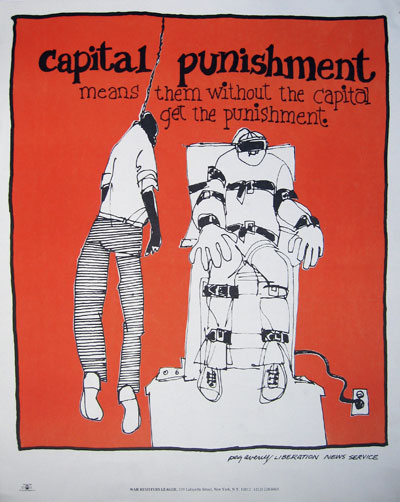
"Capital punishment means them without the capital, get the punishment." Historical poster by Peg Averill.
December 9, 2011
The death penalty should be abolished in the United States because life without parole is more humane, less discriminatory, and a less costly alternative – and it avoids the risk of executing an innocent person.
Thirty-four states impose the death penalty, including California, and there are 41 Federal capital crimes for which the death penalty can be applied. Each state has its own list of capital crimes. For example, in 1977, California reinstated the death penalty for first degree murder under special circumstances, including murder for financial gain, murder by a person previously convicted of murder, murder of multiple victims, murder with torture, murder of a peace officer, and murder of a witness to prevent testimony.
From 1976 through November 18, 2011, there have been 1,277 state executions in the United States with Texas leading with 477 and California with 13. Since the death penalty was reinstated in 1988, 58 federal defendants have been executed. As of January 1, 2011, 3,251 prisoners are on death row awaiting execution.
The death penalty is widely used because, supposedly, it acts as a deterrent. As this argument goes, people will think twice about committing a capital crime which may result in the death penalty. Yet, the murder rate in the sixteen non-death penalty states is consistently lower than death penalty states, and the gap has widened since 1990. During the 17th century, when the public hanging of pickpockets drew crowds to English cities, pockets in the crowd were being picked as the trap door was being sprung. So much for the death penalty being a deterrent!
Imposing the death penalty is much more expensive than imposing a sentence of life without parole. Why? Because the Constitution requires a long and complex judicial process for death penalty cases. This process is needed to ensure that innocent men and woman are not executed for crimes they did not commit. Even with these protections, the risk of executing an innocent person can not be completely eliminated.
According to a number of surveys, it is less expensive to imprison killers for life than to execute them. For example, California has spent $4 billion since 1978 to execute 13 people, or about $308 million for each death penalty case. And a study by Judge Arthur L. Alarcón and Paula M. Mitchell found that California spends $184 million more per year on death penalty cases than it would have for life without parole sentences.
Race also plays a significant role in the disproportionate application of the death penalty and for this reason it is considered discriminatory. For example, since 1976, while African Americans comprise just 12.1 percent of the US population, 35 percent of all death penalty sentences were handed down to African Americans . By comparison, 56 percent of death penalty defendants since 1976 were White, 7 percent Latino.
There is no way of knowing how many of the over 1,300 people executed since 1976 may have been innocent. Once the defendant is dead, there is little incentive for defense attorneys and others to continue the case. The Death Penalty Information Center has published a list of 8 inmates “executed but possibly innocent.” At least 39 US executions are claimed to have been carried out despite evidence of innocence or serious doubts about guilt.
The death penalty then is no more effective in deterring crime than a sentence of life without parole. The death penalty is discriminatory and the risk of executing an innocent person can never be eliminated. Moreover, the lengthy appeals deprive victims’ families of closure and costs states millions of dollars that could be better spent elsewhere.
Anti-death penalty advocates plan to begin a state-wide campaign to qualify the “Savings, Accountability and Full Enforcement for California Act”, or SAFE California, for the 2012 general election. If passed, the SAFE California Act would replace the death penalty with life without parole; require work and restitution into the Victim Compensation Fund; and increase public safety by directing $100 million saved from death penalty costs into a fund to solve unsolved murders and rapes. And the initiative just may pass. In September, the Public Policy Institute of California published a poll showing that 54 percent of Californians prefer life imprisonment without parole, while only 39 percent favored the death penalty.
It is time to abolish the death penalty and replace it with a sentence of life without parole. If SAFE California passes, then California may set the standard for the remaining states that still impose the death penalty.


 The Hunger Site
The Hunger Site
December 1, 2012 at 2:01 pm
Look at the Robert Gleason Jr. case. He murdered two inmates just so he could get the death penalty. There are crazy people out there that don’t care about their victims. So why should we have to think twice about killing them? I’m just saying…
October 29, 2012 at 1:48 pm
DEATH PENALTY IS NOT THE SOLUTION!
December 9, 2011 at 9:15 am
Abolish the death penalty, yes.
Replace it with life without parole, no.
30 years max.
December 9, 2011 at 6:43 am
There is precious little difference between the death penalty and life without the possibility of parole. The State is still saying that this person is unredeemable, that this person cannot be safely reintegrated back into society.
The option for parole should always be open. That does’t mean that any particular person should get parole, but there must be a means for the State to rule in favor of those who are (unfortunately) guilty.